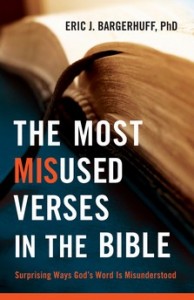(W: Cheryl is drawing again!)
Book review: The Most Misused Verses in the Bible
The Most Misused Verses in the Bible: Surprising Ways God’s Word Is Misunderstood
by Eric J Bargerhuff

Genre: Bible study
Size: 179 pages, 19 chapters, you could read the whole thing in a day. I did a chapter a day and it helped me to consider each “misused verse” better.
What’s the big idea: An invitation to come face-to-face with 17 of the most misused verses in the Bible: verses that have often lost their context today and taken on new meanings outside the stories and teachings of Scripture. The biggest lesson is to study each verse in context of the chapter, place in history and other variables to rightly understand its meaning (also called “exegesis”).
Easy to read? Yes. Each chapter deals with a frequently misunderstood verse, and takes about 5-10 minutes max. Eric uses lots of good illustrations to draw the reader in. Sentences are clear, there’s not a lot of big words used so you won’t need a theology degree to understand what he’s saying.
What I appreciated: You leave each chapter having a better understanding of verses like “Do not judge, or you too will be judged”, “Where two or three are gathered together in my name, there I am in the midst of them” and others.
For example with the “hope and a future” verse (Jeremiah 29:11—13), after good context work, Eric sums up:
Jeremiah 29:11—13 contains some great promises, but if I use it to demand the American Dream from God, then perhaps I should also be willing to literally endure seventy years of captivity first (if that’s what God should choose). I think it’s better to use it to inspire us to look for the spiritual life that is truly life now, while trusting in the future hope of the life that is yet to come.
Eric also has a gracious tone as he writes. Even if you don’t agree with his conclusions on the correct reading of a passage, you won’t find yourself hurt by how he’s explained them to you.
Who I’d recommend it to: I think this book would be helpful for new Christians in particular to see examples of how to (and how not to) interpret God’s Word. I remember as a new Christian that most of the teaching I received about Christian life came in the form of little bible verses like these, and I would have appreciated a resource like this back then. Yet even for mature Christians it’s a helpful book too, as the temptation to take shortcuts in understanding the Bible’s meaning still comes up.
Notable quotes:
“At the heart of all human sinfulness is lawlessness and the prideful appeal to be our own god. To determine our own destiny. To have our own way. To throw off restrictions and doubt the integrity of God’s goodness. To doubt the trustworthiness of his Word. And all we need to do in order to start down that path is to give Scripture a new context, twist its meaning, or interpret it in a way that appeals to the supremacy and glory of man.”
“We must also resist the temptation to make a passage “work” how we want it to work or “make it say” what we want it to say. Many have fallen prey to this temptation and as such have read into Scripture what they want to see.”
“The proper question should not be “What does this passage mean to me?” but rather “What were the author’s original intentions and how did the audience who first received it understand those intentions in the original context?” And then, only after discovering this is it appropriate to ask, “How then does the timeless biblical principle contained in this passage apply to me?””
Verdict: (on a scale of Must read, Good to read, OK to read, don’t read) Good to read
Click here to grab a copy.
——————————
Note: Thanks to Robyn Drake for her book discovery template, which I’ve adapted here.
Further reading:
- Trevin Wax also reviewed the book here.
- Chris Blumhofer dives further into Jeremiah 29:11-13.
——————————
Web Curations (5 Apr)
#apologetics
Basic facts about the books in the New Testament – Helpful to refer to, since the reliability of the Bible and what’s in it today is commonly the question posed by skeptics.
The atheist’s dilemma – Jordan Monge shares how she gradually turned from skeptic to a follower of Jesus. I’m encouraged that while she did see the intellectual inconsistency of atheism (e.g. believing in right and wrong as objective, universal categories with no reference point), it was her reading the Bible and being confronted with her sin and the Cross that softened her heart.
Easter Built on Evidence Isn’t Enough – In a similar vein, Joe Fleener points out that convincing others about the historicity of Jesus’s bodily resurrection isn’t enough – evidences alone can’t led to a genuine change of heart.
#christianliving
4 Things to Remember During Unwelcome Work – Trevin Wax gives some helpful advice for those of us in difficult, frustating vocations.
Stand for the Gospel 2013 speakers – This weekend conference (hosted by HBC) is going to have a good variety of seminar topics. I’m planning to lead one of them on hymns for the next generation, but probably most interested in what Thabiti Anyabwile has to share about evangelism across different religions.
A dramatic weight loss story – This Seven Sharp clip is so encouraging to watch. Cliff Wadsworth is Pastor of Cornerstone Baptist Church, and friends with some of the HBC family.
———————————–
The power of the gospel: 1. I am more sinful and flawed than I ever dared believe 2. I am more accepted and loved than I ever dared hope.
— Timothy Keller (@timkellernyc) April 4, 2013
6 helpful principles of communication
This morning I asked Joe, one of our pastors, a question about how to disagree and critique each other in the right spirit of truth and love (in an online blogging context).
He replied with the following six principles of biblical communication:
- Do I have the facts right? Prov. 18:13
- Is this significant enough to talk about, or can I just let it go? 1 Peter 4:8
- Is my attitude right? Matt. 7:1-5
- Is my timing right? Prov. 15:23
- Are the words I am about to use loving? Prov. 15:1
- Have I prayed for God’s help? James 1:5
On reading them, I wondered whether these were mentioned in a marriage seminar we’d been in previously, and lo and behold they were…
Seeing Our Marriage Through the Grid of the Gospel – Communication
I guess it illustrates that these principles could be helpful in a wide range of contexts: Christian relationships, Facebook discussions, talking better with your spouse, interacting with family and relatives, dealing with difficult work colleagues and probably heaps of other places (funny, the Bible tends to be helpful like that!)
—————————–
Tomb bursts into flames during Easter pageant

Unbelievable.
From Canton, Ohio, US:
Calm thinking and quick action prevented what could have been a disaster at the First Church of the Nazarene after a prop tombstone caught fire during the church’s Easter service.
“We always try to have a special day, as every Christian church does, on Easter Sunday,” Dennis said. “We have a wonderful minister of music and arts, Tim Pitzer, who had done this effect in his previous church in Virginia. He’d done it many times without any incident whatsoever.”
Dennis’ son, Paul, a youth pastor at the church, suffered second-degree burns on his left hand after he grabbed the flaming prop and carried it offstage. The younger Dennis was treated at Mercy Medical Center – but not before he played the drums as scheduled.
“Our friends said he should be wearing a Superman cape,” Mike Dennis said. “But a lot of people did a lot of heroic things.”
Among them were Dan Hanson and Kyle Groves, who helped put out the fire with extinguishers, and Jonathan White, the unflappable lead vocalist seen in the video.
That is quite something to not only keep singing, but hit all your notes with a fire burning beside you. I remember carrying on one Sunday during a song when a piece of staging fell over behind us (no pyrotechnics at HBC!). You tend to be really focused on singing that you barely notice it, if at all. Of course, the rest of the church were totally distracted while someone rushed up to fix things!
Also, is it an American thing to have a huge drama or musical outreach for Easter and Christmas services? I don’t think this church would have been the only one trying to dazzle and impress on Easter Sunday. I heard there were live camels used at Hillsong, and the Crystal Cathedral (before it filed for bankruptcy) was famed for its elaborate pageants. But where did this approach of big, attractional ministry come from? Isn’t it the opposite to simply preaching Christ crucified (1 Cor 1:22-24)?
You can watch the whole thing unfold below (credit to the speaker straight after the song too with his off the cuff comments)
——————-

